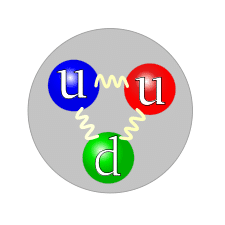Quarks- any group of subatomic particles believed to be among the basic components if matter
Quarks are believed to be the fundamental constituents of matter, and have no apparent structure. They are the particles that make up protons  and neutrons, which make up the nucleus of atoms. Also, particles that interact by means of the strong force, the force that holds parts of the nucleus together, are explained in terms of quarks. Other baryons are explained in terms of quarks(1985 Quarks).
and neutrons, which make up the nucleus of atoms. Also, particles that interact by means of the strong force, the force that holds parts of the nucleus together, are explained in terms of quarks. Other baryons are explained in terms of quarks(1985 Quarks).
Quarks have mass and exhibit spin, the type of intrinsic angular momentum corresponding to rotation around an axis, equal to half the basic quantum mechanical unit of angular momentum, obeying Pauli’s exclusion principle. This principle that no two particles having half integral spin can exist in the same quantum state(1985 Quarks).
Quarks always occur in combination with other quarks, they never occur alone. Physicists have attempted to knock a single quark free from a group using a particle accelerator, but have failed. Mesons contain a quark and an antiquark, up, down, and strange, while baryons contain three quarks distinguished by flavours. Each has a charge that is a fraction of that of an electron. Up and down quarks make up protons and neutrons, and can be observed in ordinary matter. Strange quarks can be observed in omega-minus and other short lived subatomic particles which play on part in ordinary matter(1985 Quarks).
The interpretation of quarks as physical entities poses two problems. First, sometimes two or three identical quarks have to be in the same quantum state which, because they have to have half integral spin, violates Pauli’s exclusion principal. Second, quarks appear to not be able to be separated from the particles they make up. Although the force holding the quarks together is strong it is improbable that it could withstand bombardment from high energy and neutrinions in a particle accelorator(1985 Quarks).
Quantum chromodynamics(QCD) ascribes colours red, green, and blue to quarks and minus-red, minus-green, and minus-blue to antiquarks. Combinations of quarks must contain equal mixtures of colours so that they cancel each other out. Colour involves the exchange of mass less particles, gluons. Gluons transfer the forces which bind quarks together. Quarks change colour as they emit and absorb gluons. The exchange of gluons is what maintains the right quark colour distribution. The forces carried by gluons weaken when they are close together, at a distance of about 10-13 cm, about the diameter of a proton; quarks behave as if they were free. This is called asymptomatic freedom (1985 Quarks).
When one draws the quarks apart the force gets stronger, this is in direct contrast with electromagnetic force which gets weaker with the square of the distance between the two bodies. Gluons can create other gluons when they move between quarks. If a quark moves away from a group of others because it has been hit by a speeding particle, gluons draw from the quarks motion in order to create more gluons. The larger the number of gluons exchanged the stronger the binding force. Supplying additional energy to quarks results in conversion of energy to new quarks and antiquarks with which the first quark combines (1985 Quarks).
After the discovery of “bottom” and “charm” it was believed that all quarks occur in pairs. This led to the effort to find “top” quark. In 1984 the laboratory of the European Council for Nuclear Research (CERN) in Geneva obtained experimental evidence of “top’s” existence. The discovery of “top” completes the theory of natures basic components, quarks(1985 Quarks).
Bibliography
(1985) Quarks, Encyclopedia Britanica, Encyclopedia Britanica Inc. USA.
